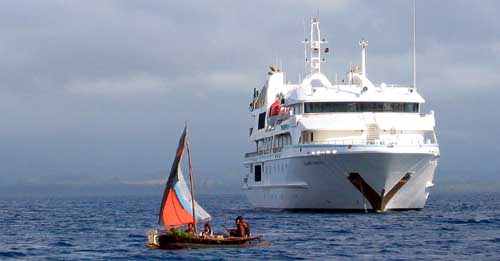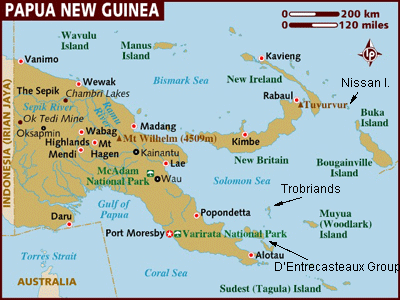A Princess in the Wild
Our Princess Makes Her International Debut

A true-blue Aussie Princess hitches up her breeches and heads north to the seldom explored waters of Papua New Guinea and the Solomon Sea.
Words and Pictures by Roderick Eime
A sea so blue and clear lay beneath the bow that the ripples in the sand, metres below, were plain to see. Small bands of bright tropical fish played tag around the anchor line, oblivious to the 2,000 tonne vessel moored in their front yard. We had just dropped anchor some 500 metres from little Dobu Island, a former missionary station within the D’Entrecasteaux Group, east of PNG, and adjacent the much larger Normanby Island. A dormant volcanic cone loomed above the disused church and derelict minister’s home as a reminder of its violent birth and constant tectonic volatility.
I’ve been aboard Oceanic Princess, the sparkling new, purpose-built expedition yacht for just two days and already we’re into waters seldom visited by any sort of western-style tourism. This is the Princess’ first international voyage, something of an exploratory one, and is populated largely by committed repeat travellers, company guests and some office staff, including doting owners, Tony and Vicki Briggs.
“We are aboard the only Australian built, flagged, owned and crewed passenger vessel currently operating international voyages,” Tony reminds us with obvious pride, “I can’t even remember the last one. I think I saw it on a commemorative stamp.”
True. Australia’s cruising market is dominated, overwhelmed even, by foreign flagged and registered vessels crewed largely by ‘international’ staff. Tony and Vicki’s company, Cairns-based Coral Princess Cruises, has been a benchmark expedition cruise operator for nearly thirty years, beginning with overnight Great Barrier Reef cruises and expanding into more elaborate operations in Cape York, the Top End and Kimberley where their product is a runaway success.
Back on Dobu a few small outrigger canoes bear villagers toward the gleaming white vessel. Although they have optimistically brought a few coconuts, yams and shells along to trade, the paddlers instead gaze up in awe at her immaculate superstructure, responding occasionally to waves from the upper decks.
“Gona gona boboana!” yells Nancy Sullivan, our ebullient resident anthropologist, and broad grins and animated waves are readily returned. Formalities out of the way, our light load of passengers is seated in Xplorer, a purpose-built tender designed to carry the entire guest compliment of 76 plus a crew of four. Instead of precariously depositing us into pitching zodiacs, Xplorer sits comfortably on a raised aft platform waiting to be lowered into the water. She is then driven easily away to her shore destination with barely a splash. It’s a dignified process for the ladies and a relief for the crew who only need to smile and show you a seat.
As Xplorer approaches the beach, throngs of villagers gather along the shore. Delightful children squeal and yelp as they dash back and forth along the sand, occasionally stopping to jump in the air, arms outstretched. We’ve rehearsed a few words of local dialect and stilted renditions of ‘Gona gona Boboana’ (Good morning) are delivered much to the delight of our hosts.
The friendly Dobu Islanders are not completely unfamiliar with ‘white’ (dimdim) customs, but clearly a visit such as this is a novelty. Nancy, her long blond hair shielding her shoulders from the intense tropical sun, is quickly swapping jokes with the ladies and a secret women’s club is immediately formed. Based in mainland Madang for nearly twenty years, Dr Nancy Sullivan is the current expert on PNG anthropology. Equipped with a quirky and disarming chuckle, she clearly displays a deep fondness for these attractive, responsive people and immediately gains their confidence with fluent tok pisin (pigeon English).
This form of shore excursion is the most genuine expedition ‘product’. After a splendid recital from angelic primary school children, a presentation of school material is made by Jamie, our expedition leader, and a tour of the village undertaken. Local folk pause from their daily routine to chat with the visiting dimdims, explaining local boat building, gardening, home decorating and cookery. A true cultural exchange is taking place and we depart amidst great fanfare, but not before three hundred excited kids are whizzed around the bay in Xplorer by Tony, who exhibits great control under very trying conditions!
On this itinerary and the next, Oceanic Princess expects to make around twenty such visits, so the storeroom is full of coloured pencils, books and sundry stationery. As we progress into ‘uncharted territory’, we learn that some of the more remote villages like Egum Islet in the Marshall Bennett Group may not see a white face for years and their welcome is a simple chit chat and basic village tour. We learn about centuries old cassava planting, the complex and enigmatic ‘kula’ trade as well as hunting and food preparation.
Then on islands like Kiriwina in the Trobriands, we get the full treatment! Exotic, eye-popping dancers, a mayoral welcome with bull-horn, refreshments and a craft market are installed for our shopping pleasure. This excursion falls into the crossover category, where villagers are more commercially savvy and spirited haggling accompanies each purchase. Notwithstanding the Trobrianders’ relative sophistication, we are treated to a cultural display that reinforces their proud reputation of sensuality and beauty and we rejoice in the obvious failure of the missionaries!
Back aboard Oceanic Princess, we all hit our respective private showers at once, which, despite our best efforts continue to dispense hot water unabated. Suitably refreshed, pre-dinner drinks in the Bridge Deck Bar are de rigour prior to our main meal in the bistro-style dining room on the lower main deck. Although no claims are made about five-star dining, meals are certainly of better restaurant standard and are complimented by a handpicked wine list. The semi-formal, almost casual, dining atmosphere is not out of place. Some passengers display a hint of sequin, others are in t-shirts, yet a dash of decorum is always reserved for dinner.
The menu varies everyday and I can attest the chefs were probably the busiest crew on the ship, despite our lighter passenger load. One menu chosen at random reads;
Entrée:
Red Lentil Soup or Sauteeed calamari on mango mesclun salad
with sweet soy dressing
Main:
Pan seared chicken breast with warm pawpaw salsa
or scotch fillet steak with a massaman curry sauce
Afters:
(on this occasion) selection of Australian cheeses
I would argue that expedition cruising is more about the destinations, whereas conventional (big ship) cruising is at least as much about the vessel. Hence, I will choose the destination over the vessel in making my cruise decision. To travel on a luxury ship with cabins as big as motel rooms is simply a welcome bonus. Yet Coral Princess Cruises find themselves in something of a quandary. The company is justifiably proud of their magnificent new vessel, purpose-built for the established itineraries and ready for new challenges, yet their marketing almost plays down the highly inspirational locations their vessels explore. So what do you do? Play the luxury cruise card like some of the close competitors or extol the brilliant destinations on offer? True, it is a difficult balance yet to find equilibrium.
Rationalise it this way; conventional “cruisers” are exploring expedition products in search of a more enriching experience, whereas the reverse transition is not so evident. Recent studies indicate that travellers are seeking more “transformational” experiences as part of their travel package. Thus it follows that “expedition cruising” is undergoing something of a boom. However, beware! Some operators may brand their product “expedition” but fall short on the “transformational” delivery.
Oceanic Princess is the product of decades of knowledge gained by Tony and Vicki Briggs and their long-serving skippers and ideally suited to the task. Despite her 63m length, she is highly manoeuvrable. On one occasion, (ex-RAN) Captain John Lynch deftly brought her 2000 tons within twenty metres of a sandy beach and later guided her up a beautiful channel just twelve metres deep. That level of seamanship delivers extraordinary results, and Tony was clearly proud of her and her crew’s capabilities.
Amid a hearty, back-slapping send off, I disembark in Rabaul where new expeditioners come aboard against an awesome backdrop of mighty Mt Tavurvur bellowing clouds of volcanic ash. After many years of ‘borrowing’ foreign expertise and ‘adapting’ vessels, Australia now has a truly national ship, crewed almost exclusively by Australians, ready to capitalise on the wonderful destinations so close at hand.
What is ‘Expedition Cruising’?
The term ‘expedition’ has been more frequently attached to cruise products in an attempt to give them a romantic, out-of-the-way appeal. The danger is that the original expedition cruise concept is being diluted and misconstrued.
A true expedition cruise consists of a voyage plan and itinerary that has inbuilt flexibility and redundancy. In the capricious Antarctic waters, all activities and sight-seeing is weather and ice dependent. Passengers are reminded of this time and time again and it is quite common for completely unscheduled landings to take place in fallback planning. The same exists in tropical waters.
As weather, currents and tides play out in the dense South Sea archipelagos, an expedition leader and his/her captain must ‘massage’ the itinerary constantly to capitalise on emerging opportunities and avoid those closing out.
A proper expedition vessel is more than just a smaller ship with zodiacs piled up on deck. A true expedition vessel is designed for the intended conditions and equipped to deliver the experience upon arrival, whether it be weaving through disintegrating pack ice or creeping past vivid coral atolls.
Passengers aboard expedition vessels have come to expect expert guides and lecturers to help them interpret the rich cultural and natural histories these exotic destinations deliver. Academics, researchers and authors are common both as lecturers and passengers, adding to healthy discussions and enrapturing dinner conversation.
Fact File:
Vessel: Oceanic Princess Cruise Line: Coral Princess Cruises Star Rating: not rated Tonnage: 1838 GRT Max Passenger Capacity: 76 Entered Service: 2005 Itineraries range from 10 to 13 nights and are priced from A$6950 twin-share. Built by NQEA in Cairns, Oceanic Princess is equipped with zodiacs, a glass-bottomed boat and a specially designed, high-powered aluminium excursion vessel with awning and toilet.
Bookings:
Further information:
|




You must be logged in to post a comment Login